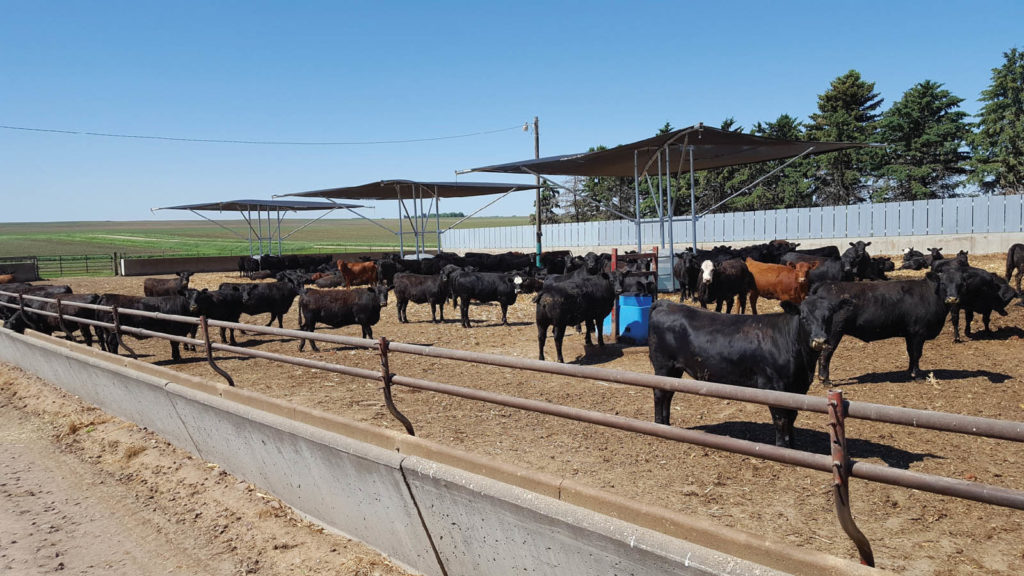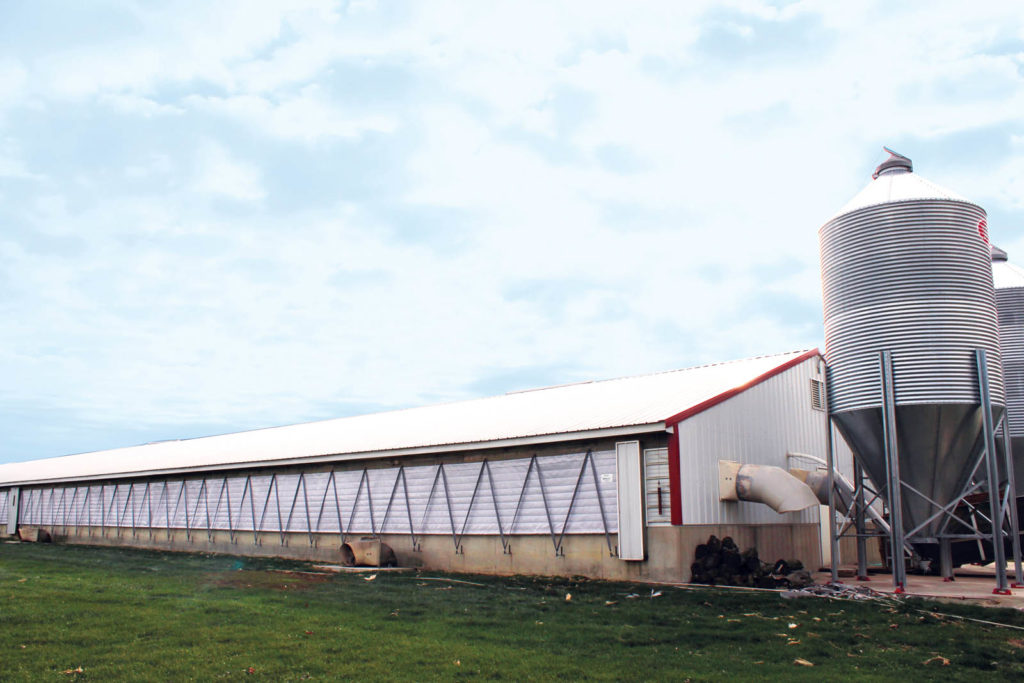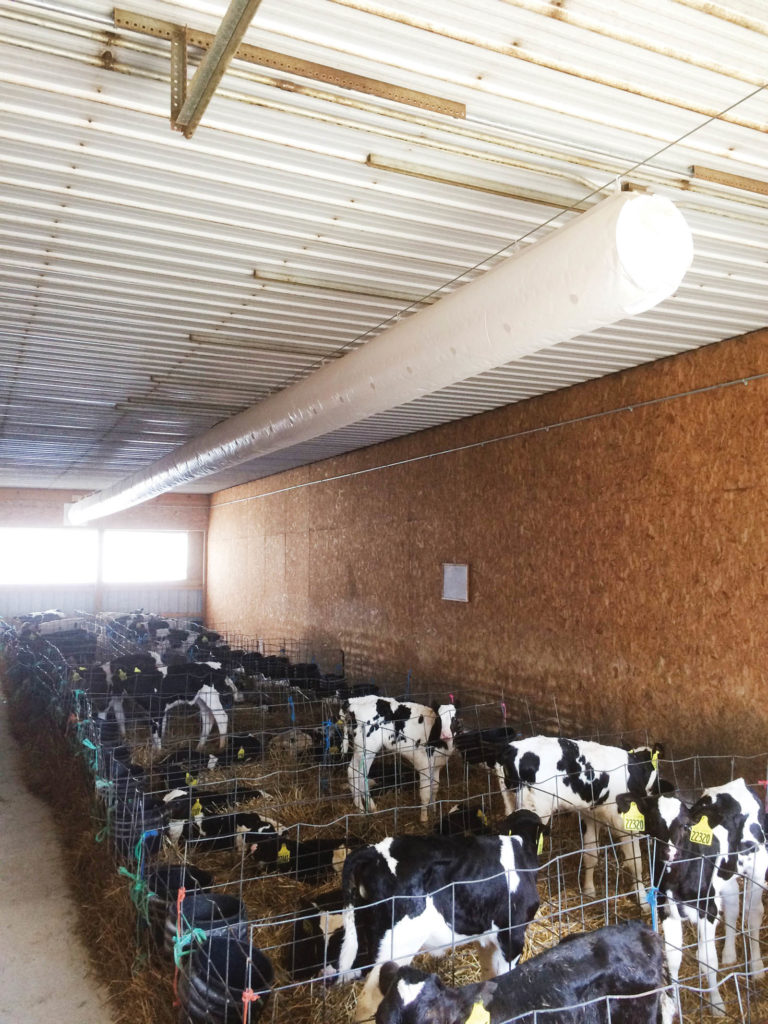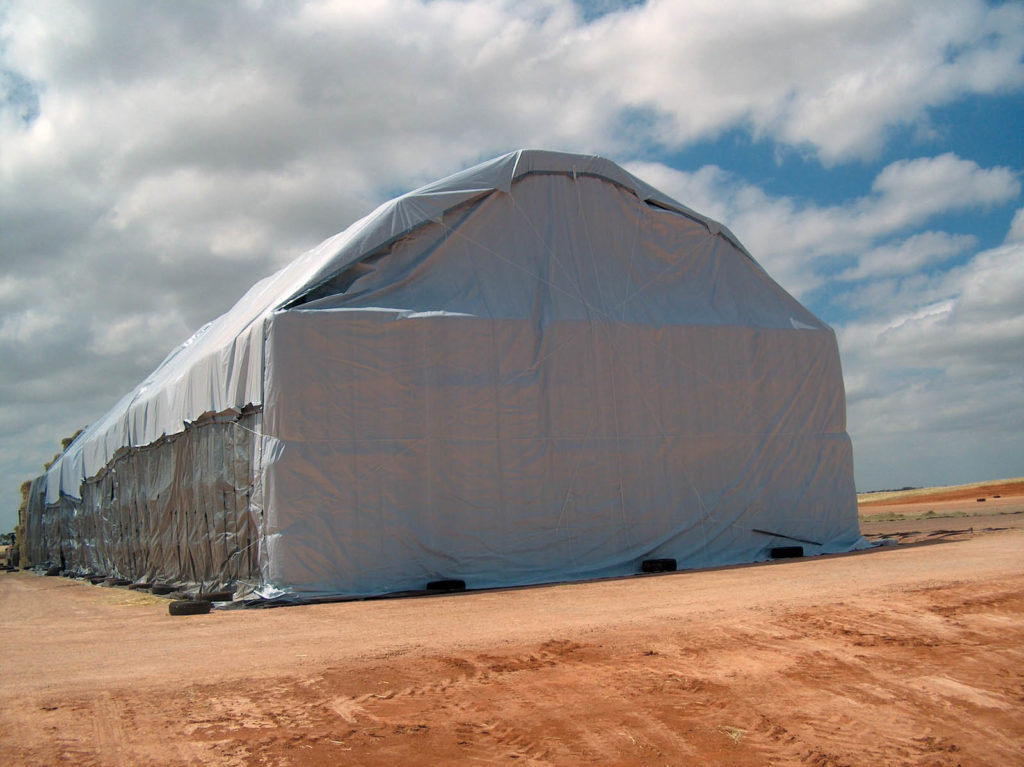Textile products for the agricultural market help to protect livestock and grain, improve yields, and make a farmer’s job a little easier and more profitable.
by Darcy Dougherty Maulsby
Call them the unsung heroes of modern food production.Today’s durable agricultural fabrics combat wind, sun, mud, moisture and other threats, helping farmers protect their grain and the well-being of their livestock. Take geotextiles, which are used for purposes ranging from ground cover to waste management.
“Huge strides have been made in the past six years in the geotextile fabrics used in agriculture,” says Stephen F. Higgins, Ph.D., director of environmental compliance for the College of Agriculture, Food and Environment (CAFE) at the University of Kentucky. “In some ways, they’re like the advanced fabrics used in golf shirts, which are breathable and wick away moisture. These modern ag geotextiles are designed to be durable and to drain well.”

Other fabrics are vital to animal health. Shade is essential to curtailing the heat stress that can cause a decrease in feed intake, milk production, weight gain and fertility in cattle, he says. For example, when Higgins used an infrared temperature gun to measure the heat in a feedlot in his area on a summer day, he discovered the gravel was 118 degrees (F). The ground was 89 degrees (F) in the shade, however. “Without proper shade, you’re looking at greater potential for heat stress, which can trigger health complications like pneumonia in weaned calves,” he says.
Research at the University of Kentucky’s Animal Research Center has revealed that beef cows and calves showed improved weight gain with the use of portable shade during the heat-stress periods of spring and early summer. An increase of 1.25 pounds per day for cows and 0.41 pound per day for calves was recorded when animals had access to shade.
Scientists at the University of Arkansas have found similar results. Providing cattle with artificial shade resulted in an average weight gain of more than 20 percent, compared to cattle with no access to shade. In addition, research from the University of Florida indicates that dairy cows provided with shade produce 10 to 19 percent more milk than cows without shade.

Keeping livestock comfortable
Understanding the farmer mindset is step one to competing effectively in the ag market. Offering practical, affordable options is step two.
“Livestock producers won’t argue that shade is critical for keeping animals comfortable and healthy,” says Dan Fathke, sales and marketing manager for Springfield, S.D.-based Rush-Co Inc., which provides livestock shade systems, vent curtains, mower covers and fabric buildings for the ag industry. “That’s why a lot of producers have invested in sprinkler systems in the last three years.”
While sprinklers work, livestock shade systems can offer an even more attractive option. “One guy who had recently installed a sprinkler system for his cattle ordered one shade system from us in the spring,” Fathke says. “He ordered a bunch more within the next year. Within a year and a half, the livestock shades had eliminated the need for sprinklers on his farm.”
Rush-Co’s shade systems, which can be permanent or portable, are engineered to withstand tough weather conditions. They are made with durable vinyl and mesh covers, along with galvanized steel that resists corrosion. The permanent shades can be installed in as little as four hours. Components that can be bolted together eliminate the need for welding, notes Fathke, who adds that the shades are offered with a five-year warranty.
“The portable shade trend started in north-central Nebraska, but now it’s spreading all over the country as more livestock producers realize the value of these systems,” Fathke says.
Rush-Co’s livestock shades are found on cattle, sheep, goat and horse farms across the United States, including at the U.S. Department of Agriculture (USDA) Grazinglands Research Laboratory in El Reno, Okla. “The USDA employees study rotational grazing, meaning they move cows every other day to a different paddock in the pasture,” Fathke says. “They use about 15 of our livestock shades. Cattle feedlot managers also like the portability of our shades, which are easy to move when it’s time to clean the feedlot.”
Family-owned Rush-Co has been in business since the 1950s, and in addition to the ag sector, the company serves the marine market and provides custom commercial products. Demand for the company’s fabric buildings has been growing in recent years, Fathke adds. These buildings help protect livestock from the elements, providing shade and cooler conditions in the summer and a more comfortable environment in the winter.
“Raising cattle under roof is a growing trend, especially in areas where there’s not enough land for pasture or the rent on existing pastures is more than a cattle producer wants to pay,” Fathke says. “Once customers put up one fabric barn, they often put up another one in a few years.”

The science of farming
Based in Celina, Ohio, Celina Industries, a division of Celina Tent Inc., fabricates products for several specialty fabrics markets including agriculture, supplying fabric curtains for barns for hogs, turkeys, dairy and other livestock.
“Each year our Agri-Barrier™ curtain business increases,” says Allan Bruns, Celina design engineer. “Farming has become such a science today. Paying attention to details like barn curtains that provide proper cross-ventilation and shade can make a big difference in the comfort, health and productivity of the livestock.”
Celina uses a variety of production techniques to ensure the durability of its fabric products. Customers can choose from triple stitching or a hot-air weld, which is often used on PVC. Today’s fabrics can offer additional benefits, such as antiwicking scrim traits to help control mold, and bacteria- and fungus-resistant properties. The company manufactures curtains from PVC or polyethylene fabrics.
Other Celina products for the agriculture market include custom ventilation tubes, which contribute to a healthier environment within livestock barns, and disinfecting mats. Farmers walk across these small mats, which are filled with a disinfectant solution, when entering a barn. This helps control disease organisms that might cling to the bottoms of farmers’ boots. Celina also stocks various sizes of hay tarps, which protect livestock feed from deteriorating during extended exposure to weather.
But there is one big thing Bruns would like to change in the agriculture market. “There’s currently no industry standard sizing for ag curtains,” he says. “Since every barn builder’s system is different, you end up with partial rolls of fabric, which is inefficient.”

Discovery process
Fabric manufacturer Herculite®Inc., Emigsville, Pa., is unique in the market in that the company manufactures the fabric for agricultural curtains in addition to fabricating the curtains themselves.
“Herculite provides custom fabrics designed to handle the demands of livestock and the punishments of harsh weather,” says David Eichelberger, business manager of Custom Engineered Solutions & Hercon Environmental for Herculite. “Our customers require products that bring them value through longer lifespan and specific features that only a manufacturer can offer.”
To develop custom solutions for many market segments including agriculture, Herculite uses what it calls a “discovery process.” This involves customers and industry experts working together during the design process to create solutions tailored to each client’s specific needs. “This [process] works well in the agricultural market, where customers might be using truck tarp vinyls that weren’t designed for their application,” Eichelberger says. “We can work together to supply a more beneficial, specific solution.”
Clients want a reliable product they won’t have to worry about, particularly farmers, whose “maintenance lists are already long enough,” he says. “If we can offer something that won’t be added back to their replacement budget for 10-plus years, farmers see not only the return on investment, but also the reduction in maintenance headaches.”
Providing options is also important. Herculite ag curtains are available in clear, translucent white, blackout and specialty fabric constructions that are manufactured to order. “Our textile products have evolved to provide the best possible solution to our customers, such as CrystalClear fabric to let in more sunlight, or R2X, a fabric designed to resist damage from rodents,” Eichelberger says. “These innovations are designed to help livestock yield more milk and help poultry grow more efficiently. At the same time, these products help reduce the replacement costs associated with farmers’ barns.”
Innovations in fabric solutions are a win-win for agriculture, Eichelberger adds. “The health, productivity and comfort of the animals mean better efficiency and ultimately more money for the farmer.”

Crop coverage
Hay tarps are essential for growers in the western United States, who export high-quality hay to the Middle East, Japan, South Korea and other corners of the globe. That’s where Inland Tarp & Liner LLC of Moses Lake, Wash., comes in.
“The hay bales are compressed into 1-foot-by-1-foot square bricks that can be palletized, shrink-wrapped and shipped overseas,” says Matt Purcell, sales manager for Inland Tarp & Liner.
Before that happens, the hay is stacked in the field and must be fully wrapped to protect the valuable product from the elements until it’s prepared for shipment. “If the hay gets rained on after it’s cut, the grower can’t export it,” Purcell says.
Inland Tarp & Liner’s sister company, ITC Services Inc., rents hay tarps. The crews that work for ITC Services maintain these tarps when they are being used on farms and ranches. Farmers who want to own their own hay tarps can purchase Inland Tarp & Liner’s products through farm stores and cooperatives.
Farmers can also buy a variety of other ag products from the company, including grain pile covers, silage films (thin membranes that trap moisture and heat so corn silage ferments properly into livestock feed) and pond liners. The company has also diversified by providing industrial geomembrane liners to the oil and gas sectors, along with fabric covers for athletic fields.
Inland Tarp & Liner continues to develop new solutions for the ag sector. The company is working with the University of Tennessee to develop new product lines that work well for hay growers in humid areas of the U.S. such as the East Coast.
“Our goal is to respond to customer needs quickly,” Purcell says. “We’re proud to make our tarps in the United States, because it’s so much easier to manage quality control.”
Sidebar: Adapt and expand
As the citrus industry struggles, Cosner Mfg. finds new markets.
The need for efficiency and profitability sometimes prompts companies to adapt their offerings for the ag market and to expand into new markets altogether. Cosner Manufacturing Co. in Lake Wales, Fla., has fabricated produce harvesting bags for decades. But in recent years, it’s been forced to adapt because of a string of threats to the citrus industry.
“Sales of fruit-picking bags have been weakening for years, and Florida citrus is on life support,” says Michael Ciferri Jr., owner of Ciferri Parts and Cosner Manufacturing.
In 2018, Florida citrus growers posted 75-year lows because of damage caused by Hurricane Irma. Growers have also faced a deadly citrus-greening disease and the expansion of urban development into rural areas, according to the News Service of Florida.
“Our focus has become animal shade, truck tarps, marine canopies and custom sewing,” Ciferri says. “Still, the future is far from clear.”
Sidebar: Farming, fabric and the future
Innovation is the key to producing advanced fabrics and fabric products that can help meet the needs of farmers.
“Ag fabrics already help provide the optimum environment for livestock to thrive; plus they help keep harvested grain or hay in condition,” says Stephen F. Higgins, Ph.D., director of environmental compliance for the College of Agriculture, Food and Environment (CAFE) at the University of Kentucky. “The fabrics of the future might be able to offer even more advantages.”
These could include dust and/or odor mitigation from a fabric curtain in a hog or turkey barn, or built-in air conditioning for evaporative cooling. Fabric could also be used for dewatering in manure lagoons. “By filtering out the liquid, you’ll essentially have a ‘vacuum cleaner bag’ where you’re moving solids that can help fertilize crops,” Higgins says. “There’s a lot of potential for advanced fabrics in agriculture.”
Darcy Dougherty Maulsby, Iowa’s Storyteller, runs her own marketing/communications company near Lake City, Iowa, where her family also raises corn and soybeans on their Century Farm. Visit her at www.darcymaulsby.com.
 TEXTILES.ORG
TEXTILES.ORG


